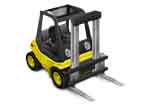Home »
The Benefits of Fire Safe Valves
The valve is one of the simplest but most vital devices to prevent catastrophe. A modest flap that alters the direction or intensity of a fluid, valves work simply by opening or closing. In their earliest forms, valves allowed fluid to travel in one direction but not in another in so-called check valves, named for their purpose of serving to check fluid motion.
Today, valves have evolved like all modern technology, advancing significantly in sophistication. Valves, considered a form of fittings or small parts of equipment, come in considerably more complex forms and use processes like automation. They serve to control everything from water flow to sewage processing to power generation.
Fire-Safe Valves
One of the most vital roles valves do is stopping fires. Activated by heat, the spring-loaded valves prevent fuel from feeding a fire. This fuel is generally a liquid such as oil. When exposed to heat, the valves snap shut, and the fluid which fueled the fire is shut off. The valves stop the flow and minimize any potential leakage fueling the fire. The valves appear in every kind of equipment, small or large, on the market.
Why Should You Use Fire-Safe Valves
There are several important reasons to use a fire-safe valve. The most straightforward reason is to protect human lives. A fire-safe valve is one of if not the most critical pieces of technology when dealing with combustibles. There are material benefits as well, from protecting equipment and the environment to simply cutting insurance rates.
Fire-Safe Ball Valves
One of the most common fire-safe valves is a ball valve. In this piece of equipment, a metal ball floats between two seats. When the valve reaches an excessive temperature, the seats warp, releasing the ball against the end cap and forming a tight metal-to-metal seal that prevents further leaking. These seals may also have stem seals with the top part sitting in the fluid to prevent further leakage.
Fire Safe Fusible Links
Another common type of fire-safe valve is a fusible link valve. Fusible link valves use a trigger assembly and a link to maintain pressure on a spring pack. This keeps the valve open under safe and normal circumstances. When a fire erupts and causes a threat, the fusible link breaks as it reaches an excessive temperature. This allows the spring pack to close the valve, preventing further flow of fluids. These valves have two seats, a TFE seat and a metal seat designed for isolation, along with graphite seals enhancing the seal’s protection.
Butterfly Valves
More cost-effective, a fire-safe butterfly valve is a popular option for safety. Butterfly valves have rods in discs that turn with or against the flow. The valve is a quarter-turn valve which makes the valve fully closed or open when turned a quarter turn. These valves can be restricted or released as much as the situation requires within that quarter turn. A fire-safe butterfly valve is extremely easy to use in an emergency, making it a safe, trustworthy option.
The Degrees of Fire-Safe Valves
There are three levels of fire-safe valves. Fire-safe by design valves are built for fire safety, but in the absence of testing, they cannot be said to truly be fire safe. Fire-safe tested valves are unapproved by a governing third party but have been tested. Finally, fire-safe approved and certified valves have achieved certification by a third party.
API 607
No valve can be trusted more than an API 607 fire-safe valve. API 607 is one of the standard fire safety tests used for valves in the petroleum industry. Developed by the American Petroleum Industry or API, these are the benchmarks a valve can be trusted in an emergency.
In such a test, the valve is put through a 30-minute duration. Generally, after a half hour of fighting, a fire, withdrawal, and containment is called for. A water-filled, pressurized valve is exposed to extreme temperatures of up to 1000 degrees celsius with thermocouples and calorimeter cubes measuring the intensity of the heat. During the test, leakage inside and out is measured, ideally falling within an acceptable limit. Following the test, the pressure-containing abilities of parts such as the seal, seats, and shell are examined and put to further tests.
The API 607 test is for valves without metallic seating under pressure and quarter-turn valves. For valves with metal seating falling under the API 6A and API 6D valve requirements, the API 6FA test is used.
Having a quality valve you can trust in an emergency is a must. Fire safety is vital to saving everything from lives to property. Having quality equipment can make all the difference. For that reason, you should be sure the valve you have holds up.
At Valtorc, we offer a wide range of fire-safe valves. We have hybrid fusible link-ball valves and fusible link butterfly valves, all of which are available in carbon steel, ductile iron, and stainless steel. The temperature range on the links ranges from 165F-300F. These valves are easy to install with instructions provided on the site. The valves are American Recovery and Reinvestment Act compliant and ship from a factory in the United States.
We pride ourselves on the quality of our products. With over 40 years in the business, we’re proud to be one of the nation’s leading experts on various valves. Contact us today with your valve needs.

CREDIT APPLICATION
Please fill out our credit application for purchase orders and net terms. Download here

DISTRIBUTORS WANTED
Apply to become an official protected distributor. Click here to fill out our distributor application. (Online Form)
VALVE PRODUCT CATALOG
New! Download our 2018 product overview catalog or call us to request a copy. Click here to download (PDF)
